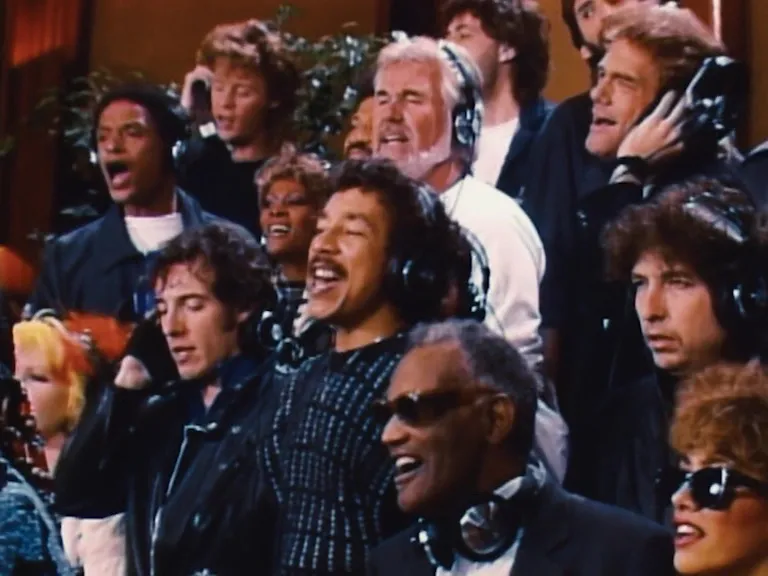On the evening of January 28, 1985, a who’s who of American music – everyone from Michael Jackson to Bruce Springsteen–convened in Los Angeles at A&M Studios to record the song, We Are The World, which went on to raise 80 million dollars for African famine relief. How it all came together is a wonderful story, and the poignant documentary The Greatest Night In Pop tells it expertly. The Greatest Night in Pop features interviews with many of the song’s participants, including Bruce, Smokey Robinson and Lionel Richie, who co-wrote the song and is the doc’s narrator.
The film lives up to its title.
The project was Harry Belafonte’s idea. Inspired by Bob Geldof’s African famine relief song, Do They Know Its Christmas, Belafonte put the ball in motion. He called music manager-TV producer Ken Kragen who contacted Lionel who reached out to Quincy Jones who hit up MJ and so on. In all, about 47 superstars participated.
With the artists signed on, the philanthropic effort just needed a song, one that would be a call to action for the world – hopefully. Geldof had already raised the bar high, so the pressure was on. Lionel and MJ did come up with the song, well, most of it. Stevie Wonder was supposed to be part of the writing team, but he went MIA. Stevie would more than redeem himself later, but not everyone bought into the music. Cyndi Lauper almost didn’t show because her unnamed boyfriend very incorrectly didn’t think it was a hit.
USA For Africa had one night to nail We Are The World. Most of the music industry was in Los Angeles for the American Music Awards, so that was the logical date to record. Bruce, who was just finishing up his Born In The USA tour, wasn’t at the AMA’s, but he flew in from Buffalo.
On the big night, the talent passed the now-famous sign on the recording studio’s doorway, “Check your ego at the door,” which Quincy had posted. A grim Geldof sternly reminded the stars of the evening’s dire purpose. The performers passionately sang the chorus. Diana Ross stood in the front row between MJ and Stevie, clasping their hands. Solidarity was everywhere. However, behind the scenes, another drama was playing out.
Would Prince show?
Quincy envisioned Prince and MJ, the two rivals, singing off one another. Prince, however, wanted to do a guitar solo–in a separate room. This was problematic because there’s no guitar in the song, and everything was taking place in one room. They summoned Shelia E. to sway Prince, but instead, well, Prince wound up donating a song to the album.
Regardless, there’s plenty of terrific, intimate footage in Greatest. This is no artificial music video. We see and hear the greats, miscues and all. Al Jarreau struggles through a few takes. Al started celebrating early, hitting the vino before he wrapped. Lauper had to remove her noisy jewelry because the mics kept picking them up. And then there’s Bob Dylan, who appears uneasy. With a little assistance from Stevie, Dylan is able to find his groove. It’s wonderful to see these two collaborating. And it’s also a lot of fun to see the stars attempt to one up one another during the solo recordings. Huey Lewis, who gives some great, self-deprecating commentary, replaced Prince in the solo line-up.
At the end of the night, which is actually the morning, Ross is the last to leave the studio, and she’s in tears. She didn’t want this glorious, once-in-a lifetime night to end. I watched through the doc’s closing credits. I felt the same way.

